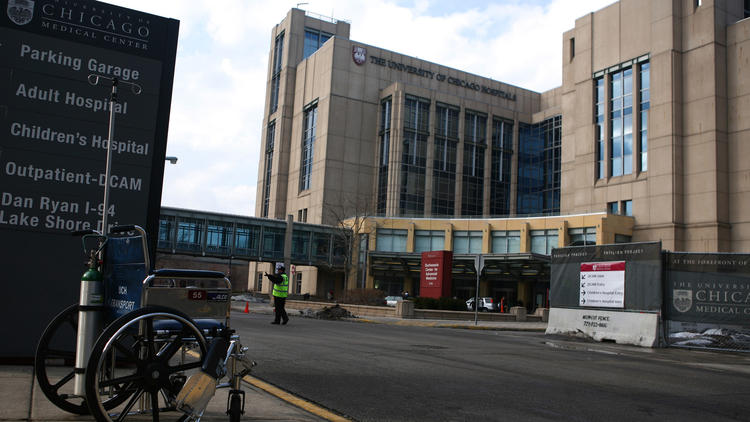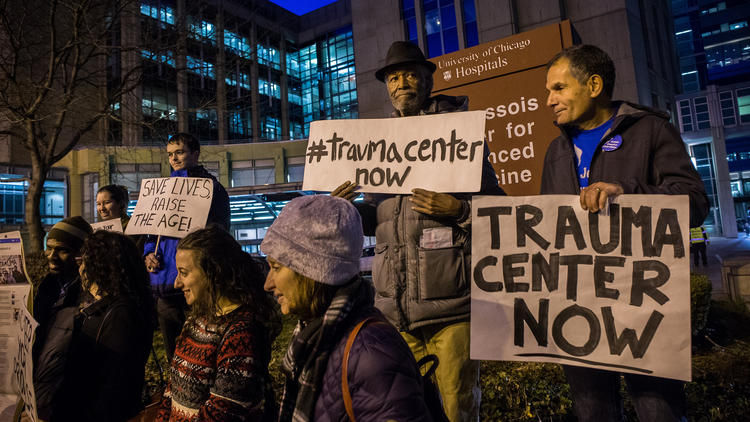News
In about-face, U. of C. Medicine to build adult trauma center on Hyde Park campus

IMAGE CAPTION
CAPTION
-->
University of Chicago Medicine's announcement Thursday that it would add Level 1 adult trauma care to its Hyde Park campus culminated a decadeslong battle with South Side residents who insisted that the university had a civic duty to provide services in an area that suffers disproportionately from gun violence.
Giving in to the community's demands, U. of C. Medicine abandoned its long-standing counterargument that trauma care on the underserved South Side should not be its responsibility alone. So in a surprise move, the hospital decided to step out on its own and open a trauma unit in early 2018.
U. of C. Medicine ditched a partnership formed just three months ago with Sinai Health Systems to open a trauma center at Holy Cross Hospital on the Southwest Side. Under that plan, U. of C. Medicine was to foot the bill for the $40 million project that still would have left much of the South Side underserved.
After weeks of studying the Holy Cross proposal, U. of C. Medicine officials decided it would be more cost-effective and a better use of staff resources to add trauma care to the new emergency room expansion project already planned for the campus, according to Sharon O'Keefe, president of the medical center. Sinai got the news just two days ago, a spokeswoman said.
The new adult trauma care will become part of an integrated health system network at U. of C. Medicine that includes the Level 1 pediatric trauma program, the Burn and Complex Wound Center and the expanded emergency room that will be built adjacent to the acute care center that opened two years ago.
"When Sinai contacted us about creating a unique collaborative approach, it was promising, and we both were very enthusiastic," said O'Keefe, who jointly announced the collaboration in September with Sinai President and CEO Karen Teitelbaum. "But when we looked at how to design our new emergency department and make the investment to expand capacity, we realized the opportunity to design that to accommodate trauma was right now."
Since the now-defunct Michael Reese Hospital in Bronzeville closed its trauma care center in 1991, South Side residents have been forced to travel as far as 10 miles by ambulance to be treated for life-threatening injuries. Activists who were never satisfied with the Holy Cross proposal said U. of C. Medicine's decision to offer services in the more centrally located Hyde Park was a victory for the South Side.
South Side youth organizers praised the decision and took credit for the hospital's about-face.
"This movement didn't start with a mayor or an alderman," said Veronica Morris-Moore, an activist with Fearless Leading by the Youth. "The people who carried this message were young, black people — we were standing up for our lives. This was not just about protest, or about expressing anger. It was about forcing leaders to see the humanity in us. Health care is something we deserve."
Last fall, U. of C. Medicine announced a concurrent plan to build a $35 million emergency room on its Hyde Park campus. The existing emergency room will be moved into the new facility on Cottage Grove Avenue, which will be connected via an underground tunnel to the Center for Care and Discovery, which houses operating rooms and intensive care units, officials said.
At the time, opponents of the Holy Cross plan argued that it would seem to make more sense to include a trauma center in that facility. While designing the new facility, U. of C. Medicine reached the same conclusion. She said the exact cost of the project has not been determined.
By combining the adult trauma center, the pediatric trauma program and the burn unit, U. of C. Medicine officials said they will be able to provide acute services for patients at one site. In addition, they said, it will provide a substantial increase in the number of inpatient beds and better serve patients with serious conditions such as cancer and heart disease who need complex surgical and other procedures.
"It has been a bit of a journey, but we are absolutely looking at the best possible solution we could find to meet the needs of the community," O'Keefe said. "We have done a very thorough, methodical approach. We've talked with the community, and they have been engaged.
"At the end of the whole planning process, the best news is that there will be a brand new Level 1 adult trauma center for the South Side that will enhance the entire trauma care network in the city of Chicago," she said.
In a statement Thursday, Teitelbaum said Sinai supported U. of C. Medicine's decision.
"From the very beginning, what has mattered most is making sure that patients have access to the highest level of trauma care where the needs are great," she said. "Ultimately, we are gratified that trauma care will be restored in an area of Chicago that is in urgent need of these services."
While Holy Cross will not become a Level 1 trauma center, it would continue business as usual as one of the busiest emergency care centers in the state, the Sinai spokeswoman said.
Mayor Rahm Emanuel also issued a statement of his support.
"Having access to a Level 1 adult trauma center, alongside increased access to emergency and specialty care, will strengthen health care on the South Side and put essential medical services closer within the reach of more residents," Emanuel said.
There are four adult trauma centers in the city: Stroger Hospital and Mount Sinai on the West Side, Northwestern Memorial Hospital on the Near North Side and Advocate Illinois Masonic Medical Center on the North Side. Other Level 1 adult trauma centers in Cook County are in Oak Lawn, Maywood, Park Ridge and Evanston.
For years, residents on the South Side bemoaned the fact that there was no trauma center that served older teens and young adults — who are more frequently the victims of shootings or injured in car accidents, which make access to emergency health care crucial.
Being within 5 miles of high-quality care is crucial to saving lives. A study published in 2013 found that people shot more than 5 miles from a trauma center — areas called "trauma deserts" — were 23 percent more likely to die.
Last December, U. of C. Medicine announced it would raise the age limit to 17 for its pediatric trauma center. With an adult center in the works, O'Keefe said the pediatric center likely will drop that effort and continue to see patients up to the age of 15.
The issue of trauma center access on the South Side moved to the front burner again in 2010 after the shooting death of Damian Turner, an 18-year-old activist who had to be rushed from Woodlawn to Northwestern downtown for care after he was injured. Turner's friends and family believed he would have survived if he had gotten treatment at the University of Chicago, which is just blocks from where he was hurt.
Turner's mother, Sheila Rush said Thursday she was overwhelmed by the university's decision to offer care right in the community where her son lived and where he had suffered.
"Let this day go down in history and let it be known that it was the youth organizers that made this come about," she said. "If Damian was here today, you would see the biggest smile, and he would be so happy. His death was not in vain. This victory shows that you must do what you can, until your last breath, if you believe in it. You can make a difference if you are willing to fight."

Activists with The Trauma Care Coalition hold a rally at the University of Chicago Medical Center in Hyde Park on Wednesday, Dec. 9, 2015. (Zbigniew Bzdak / Chicago Tribune)
Activists with The Trauma Care Coalition hold a rally at the University of Chicago Medical Center in Hyde Park on Wednesday, Dec. 9, 2015. (Zbigniew Bzdak / Chicago Tribune)
When the activists at Fearless Leading by the Youth first started pressing the university in 2010 to admit older patients, the group included a small collection of neighborhood and community residents. The group made headlines by storming the lobby of the hospital, staging protests during important gatherings on campus and getting arrested at demonstrations. The group members' cause gained momentum when a growing number of U. of C. students and some medical staff from the hospital began rallying with them.
The protesters shot into the public spotlight as the university made a bid to host the Barack Obama Presidential Center. Over time, the protests expanded to include other civic organizations as well as clergy.
Upon hearing the news Thursday, Morris-Moore choked back tears.
"From the time I graduated high school, I devoted everything to this campaign. I started to think it wasn't tangible. I was prepared to fight five more years. But we are here, getting everything we have asked for," she said.
"Young, black leadership is having an impact, and we are forcefully bringing change and improvements to our community and city," she said.